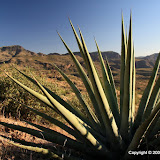I wanted to get some pictures of agave flowers. I can't believe Skidplate didn't get any when he was driving out Apache Trail last weekend. That's where I went, and there were lots of agave flowers. It's one of those things that looks great but it's hard to get a good picture of it. That didn't stop me from taking pictures, though.
I also wanted to experiment with using a single RAW image to generate a pseudo-HDRI. Normally, I take 3 exposure bracketed jpeg images and use those to generate the HDRI. You have to stand very still, though, or use a tripod. Carrying a tripod is OK in cooler weather, but when it's hot I need to keep a bottle of water in my hands, and I don't like hiking with something in both hands. Having 3 or 4 hands would solve this dilemma, and many others, but I don't think that's an achievable solution. Plus, where would you buy shirts? Anyway, RAW images have a wider dynamic range than jpeg images. It's wider than the typical monitor can display. A pseudo-HDRI image takes advantage of that wider dynamic range of the source image to produce an HDRI. Using one image means I don't have to stand completely still for almost a second. It still takes forever to process, though.
I took all pictures using jpeg+RAW, meaning they were stored in both formats. I generated pseudo HDRIs for all of the pictures. The interesting result is that, at least for pictures of agave flowers, I prefer the jpeg. I need to try this with some cloud pictures, too. Let's look at some pictures to see what I'm talking about.
I'm not too crazy about the jpeg version.

But the pseudo HDRI version looks washed out, even though I adjusted the contrast. OK, maybe this is just a bad picture.
I like the way the sky looks in this one, but the buzzard is almost unnoticeable.

The buzzard shows up much better here.
This jpeg shows some detail of the buzzard.

If you want to see the details, though, the pseudo HDRI excels. BTW, I don't think I could afford a camera that could take three images of a flying bird for an HDRI.
In this jpeg, the upper left is washed out, and the right side seems too dark.

I think I like the way the pseudo HDRI of this scene turned out better.
The flowers stand out in this jpeg.

The flowers are lost in the background of this pseudo HDRI.
I like the deep blue sky in this jpeg.
The artist in me likes the way the heart-shaped pad stands out in this jpeg.

The engineer in me likes all the detail visible in this picture.
One reason I took this picture was because of the agave at the base of the saguaro. Did you even notice it?

In the pseudo HDRI, the agave stands out better.
At first, I couldn't decide if I liked the jpeg or the HDRI of this one. After 1.5 beers, I think the artist is winning and I like this jpeg.

You can see more of the agave here, but that isn't necessarily a good thing. (The engineer is still saying, "Yes it is. Yes it IS".)
Based on this small sample, it looks like HDRIs are good in only a small number of circumstances. I've only investigated a small number of circumstances though. I've learned a few things, but I need to experiment some more. Stay tuned.
Click below to see more of the pictures, including pictures of a couple of people that jumped off one of the one lane bridges over Canyon Lake.
 |
| 2009_06_22 |
















2 comments:
How do you process the RAW image?
It's under "Automate".
Post a Comment